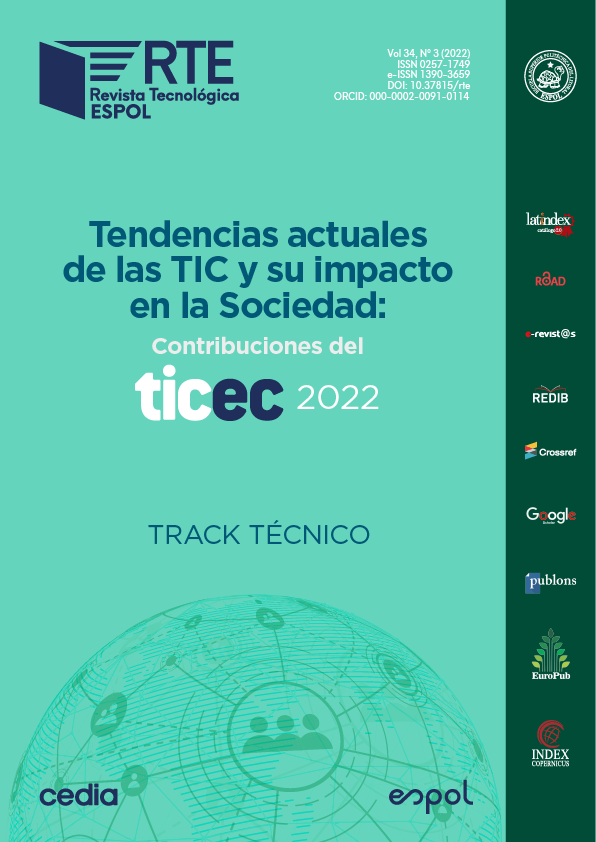Industrialization and the rapid growth of urban areas are alarmingly increasing the presence of air pollutants. These pollutants affect the quality of life of people and present an opportunity for study is created to determine the atmospheric behavior and relationship between meteorological variables present in the environment. Prior to this, rolling windows of time were applied to remove anomalous data. Next, variables were identified, and the data was segmented through the X-means algorithm. Also, two clusters that represent the relationships between pairs of variables and the temporality of the time windows. As a result, an inverse correlation of -0.78 was found between the ozone and dew point variables within the hours of the working day.

This work is licensed under a Creative Commons Attribution-NonCommercial 4.0 International License.
References
Brook, R. D., Rajagopalan, S., Pope, C. A., Brook, J. R., Bhatnagar, A., Diez-Roux, A. V., Holguin, F., Hong, Y., Luepker, R. V., Mittleman, M. A., Peters, A., Siscovick, D., Smith, S. C., Whitsel, L., & Kaufman, J. D. (2010). Particulate matter air pollution and cardiovascular disease: An update to the scientific statement from the american heart association,. Circulation, 121(21), 2331–2378. https://doi.org/10.1161/CIR.0b013e3181dbece1
Chong, K. C., Lau, W. J., Lai, S. O., Thiam, H. S., & Ismail, A. F. (2019). Preparation and Characterization of Chromium Metal Organic Framework for Carbon Dioxide Adsorption. IOP Conference Series: Earth and Environmental Science, 268(1), 012010. https://doi.org/10.1088/1755-1315/268/1/012010
Clifford, A., Lang, L., Chen, R., Anstey, K. J., & Seaton, A. (2016). Exposure to air pollution and cognitive functioning across the life course—A systematic literature review. Environmental Research, 147, 383–398. https://doi.org/10.1016/j.envres.2016.01.018
Franchini, M., Mengoli, C., Cruciani, M., Bonfanti, C., & Mannucci, P. M. (2016). Association between particulate air pollution and venous thromboembolism: A systematic literature review. European Journal of Internal Medicine, 27, 10–13. https://doi.org/10.1016/j.ejim.2015.11.012
Fränti, P., & Sieranoja, S. (2018). K-means properties on six clustering benchmark datasets. Applied Intelligence, 48(12), 4743–4759. https://doi.org/10.1007/s10489-018-1238-7
Goel, A., Ray, S., Agrawal, P., & Chandra, N. (2012). Air Pollution Detection Based on Head Selection Clustering and Average Method from Wireless Sensor Network. 2012 Second International Conference on Advanced Computing Communication Technologies, 434–438. https://doi.org/10.1109/ACCT.2012.18
Gu, K., Qiao, J., & Lin, W. (2018). Recurrent Air Quality Predictor Based on Meteorology- and Pollution-Related Factors. IEEE Transactions on Industrial Informatics, 14(9), 3946–3955. https://doi.org/10.1109/TII.2018.2793950
Juneja, A., & Das, N. N. (2019). Big Data Quality Framework: Pre-Processing Data in Weather Monitoring Application. 2019 International Conference on Machine Learning, Big Data, Cloud and Parallel Computing (COMITCon), 559–563. https://doi.org/10.1109/COMITCon.2019.8862267
Kumar, P., & Krishan Wasan, S. (2010). Analysis of X-means and global k-means USING TUMOR classification. 2010 The 2nd International Conference on Computer and Automation Engineering (ICCAE), 5, 832–835. https://doi.org/10.1109/ICCAE.2010.5451883
Lan, Y., & Dai, Y. (2020). Urban Air Quality Prediction Based on Space-Time Optimization LSTM Model. 2020 3rd International Conference on Artificial Intelligence and Big Data (ICAIBD), 215–222. https://doi.org/10.1109/ICAIBD49809.2020.9137441
Lind, D. A., Marchal, W. G., & Wathen, S. A. (2012). Estadística aplicada a los negocios y a la economía (15th ed.). McGraw-Hill.
Murray, R. S., & Larry, J. S. (2009). Estadística (4th ed.).
Orellana, M., Lima, J.-F., & Cedillo, P. (2021). Discovering Patterns of Time Association Among Air Pollution and Meteorological Variables. In K. Arai (Ed.), Advances in Information and Communication (pp. 205–215). Springer International Publishing. https://doi.org/10.1007/978-3-030-73103-8_13
Ostadabbas, S., & Jafari, R. (2010). Spectral Spatio-Temporal template extraction from EEG signals. 2010 Annual International Conference of the IEEE Engineering in Medicine and Biology, 4678–4682. https://doi.org/10.1109/IEMBS.2010.5626411
Othman, Z. A., Ismail, N., & Latif, M. T. (2017). Association rules of temperature towards high and low ozone in putrajaya. 2017 6th International Conference on Electrical Engineering and Informatics (ICEEI), 1–5. https://doi.org/10.1109/ICEEI.2017.8312438
Othman, Z. A., Risdiyanto Ismail, N., Aziz Hamdan, A., & Mahmoud, S. (2016). KLANG VALLY RAINFALL FORECASTING MODEL USING TIME SERIES DATA MINING TECHNIQUE. 92, 8.
Parker, A. (1983). Contaminación del aire por la industria (1st ed.). Editorial Reverté. https://www.reverte.com/libro/contaminacion-del-aire-por-la-industria_91542/
Paulose, B., Sabitha, S., Punhani, R., & Sahani, I. (2018). Identification of Regions and Probable Health Risks Due to Air Pollution Using K-Mean Clustering Techniques. 2018 4th International Conference on Computational Intelligence Communication Technology (CICT), 1–6. https://doi.org/10.1109/CIACT.2018.8480232
Russell, S. J., & Norvig, P. (2003). Artificial intelligence: A modern approach (2nd ed.). Prentice Hall/Pearson Education.
Simioni, D., & United Nations (Eds.). (2003). Contaminación atmosférica y conciencia ciudadana. Naciones Unidas, CEPAL.
Yang, X., Tang, K., & Yao, X. (2009). The Minimum Redundancy – Maximum Relevance Approach to Building Sparse Support Vector Machines. In E. Corchado & H. Yin (Eds.), Intelligent Data Engineering and Automated Learning—IDEAL 2009 (pp. 184–190). Springer. https://doi.org/10.1007/978-3-642-04394-9_23
Yu, S. S., Chu, S. W., Wang, C. M., Chan, Y. K., & Chang, T. C. (2018). Two improved k-means algorithms. Applied Soft Computing Journal, 68, 747–755. https://doi.org/10.1016/j.asoc.2017.08.032
Zhang, X., Zhang, X., & Chen, X. (2017). Happiness in the air: How does a dirty sky affect mental health and subjective well-being? Journal of Environmental Economics and Management, 85, 81–94. https://doi.org/10.1016/j.jeem.2017.04.001







